 The Fraunhofer Institute for Photonic Microsystems (Fraunhofer IPMS) is a research institute dealing with electronic, mechanical and optical components and their integration into devices and systems.
The Fraunhofer Institute for Photonic Microsystems (Fraunhofer IPMS) is a research institute dealing with electronic, mechanical and optical components and their integration into devices and systems.
The Fraunhofer IPMS has been working on OLED since 2000, and in 2009 it launched a new department called COMEDD (the Center for Organics, Materials and Electronic Devices Dresden) to handle its OLED research and pilot fabrication. COMEDD was turned into an independent Fraunhofer Institute in 2012, later it became a business unit at Fraunhofer FEP, and in early 2024 it moved back into the IPMS.
The COMEDD researchers used to develop OLED lighting technologies, and OLED microdisplay technologies. Today most of the focus is into OLED microdisplays.
Maria-Reiche-Str. 2
01109 Dresden
Germany
The Fraunhofer FEP developed a way to micro-pattern OLED lighting panels using electron beam
The Fraunhofer FEP developed a new way to micro-pattern (structure) OLED lighting panels using electron beam. The idea is that you create a regular non-patterned OLED and after the encapsulation you use an electron beam that penetrates the encapsulation and changes the luminous characteristics of the organic layers beneath.
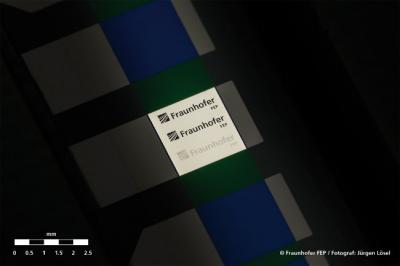
Depending on the application, it is even possible to modify individual layers directly. In their demonstration, the researchers showed it is possible to create gray scales in an image.The longer the dwell time on one spot with the beam, the darker the OLED will appear there.
The Fraunhofer demonstrate new ultra-thin flexible transparent OLED lighting panels
The Fraunhofer FEP is demonstrating their new full-plastic OLED lighting panels at LOPEC 2016. In the video below, you can see Fraunhofer's new transparent flexible OLED tiles.
The most interesting demonstrator is the "night fly", which was developed as part of the Flex+ project. Those OLEDs (also flexible and transparent) are 0.3 mm thick and feature a new lime yellow emission color. The OLEDs in the "night fly" were processed on flexible substrates and finished graphically with screen-printing in a second step. The three-dimensional body of this fly is formed through a simple sticking together with an additional film. Extremely thin conductors are provided for electrical contacts that simultaneously serve as structural supports for the fly.
The EU concludes a project aimed to develop flexible electrodes and barrier materials
In 2012 the EU launched the TREASORES project (Transparent Electrodes for Large Area Large Scale Production of Organic Optoelectronic Devices) that aimed to develop technologies that will lower the production costs of organic electronic devices.
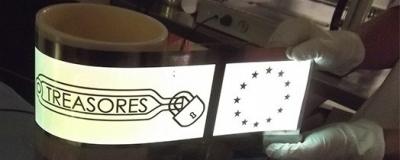
The Fraunhofer FEP now reports that the project concluded successfully and one of the results was the development of several new transparent electrode and barrier materials. The project partners developed electrodes based on carbon nanotubes, metal fibres or thin silver - and these electrodes (some of which are already mass produced) enabled the creation of the OLED lighting device you can see above.
The EU aims to create a European-wide flexible OLED lighting pilot line
 The EU launched a new project, called, PI-SCALE, that aims to create a European-wide pilot line which will enable companies of all sizes to quickly and cost effectively test and scale up their flexible OLED lighting concepts and turn them into market ready products.
The EU launched a new project, called, PI-SCALE, that aims to create a European-wide pilot line which will enable companies of all sizes to quickly and cost effectively test and scale up their flexible OLED lighting concepts and turn them into market ready products.
PI-SCALE will offer world class capability and services in the pilot production of customized flexible OLEDs and initially focuses on product streams in the areas of automotive, designer luminaires and aeronautics applications. The pilot line will be available during and after the lifetime of the project to companies on an open access basis, and the specialist infrastructure will include all the steps required to turn OLED lighting concepts into manufactured products.
The Fraunhofer Institute gives more details on their graphene-based transparent OLED electrode
Finding an alternative for ITO as a transparent electrode is one of the major flexible OLED challenges. A few days ago, The Faunhofer Institute FEP demonstrated an OLED device that has a graphene electrode, developed as part of project GLADIATOR.
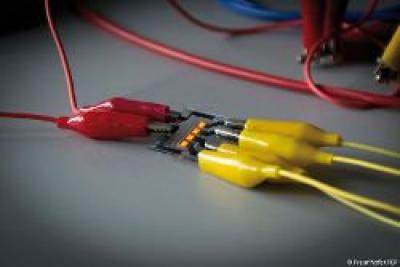
The Fraunhofer developed the device in collaboration with Spain-based Graphenea, which supplied the CVD-produced monolayer graphene. Graphene-Info posted an interview with the project's coordinator who further explains the technology, why graphene is promising and what are the challenges that still has to be solved before graphene transparent electrodes can be commercialized.
Fraunhofer to demonstrate an OLED device with a graphene-based electrode
The Faunhofer Institute FEP is going to demonstrate an OLED device that has a graphene electrode, developed as part of project GLADIATOR. The Fraunhofer developed the device in collaboration with Graphenea, which supplied the CVD-produced monolayer graphene.

This first demonstrator is a small OLED device. The partners in this project now aim to create a larger-sized OLED with an active area of 42 cm2. They also plan to develop a fully-flexible transparent OLED, with an active area of 3 cm2.
Fraunhofer demonstrates an SVGA OLED bi-directional microdisplay
The Fraunhofer Institute has been developing bi-directional OLED microdisplays for years, and they now demonstrate their latest prototype that features an SVGA resolution - up from VGA in the previous prototype shown in 2012.
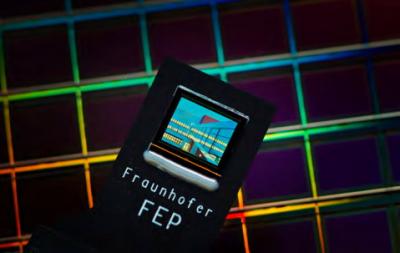
Besides the increased resolution, the new microdisplay also features a higher resolution image sensor and an enhanced color depth. Fraunhofer also integrated more components directly into the microdisplay chip, which will make integration easier.
The Fraunhofer Institute shows transparent color-tunable OLED lighting panels
Fraunhofer FEP's COMEDD developed new color-tunable transparent OLED lighting panels. These panels were presented at the LOPE-C exhibition last week, and they looked very nice.
According to the Fraunhofer color tunability is the most wanted feature (after flexibility) by lighting designers. The Fraunhofer uses a stacked approach (unlike Pioneer's stripe-pattered RGB-OLEDs, for example). A stacked approach enabled the Fraunhofer to make the panels both color-tunable and transparent - in any shape.
Up close and personal: Dr. Uwe Vogel
Today's personal OLED interview features Dr. Uwe Vogel from the Fraunhofer Institute in Germany.If you wish to be featured on such interview, contact us here.
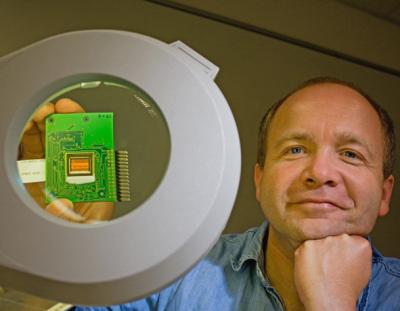
Dr. Uwe Vogel, Head of Division Microdisplays & Sensors, Deputy Director, Fraunhofer Institute for Organic Electronics, Electron Beam and Plasma Technology FEP, Dresden, Germany
What was the last book you read? OLED Microdisplays, Technology and Applications, Edited by Francois Templier, 2014 (though I am NO author there ;o)
The Fraunhofer FEP demonstrates OLED-based thin-film personal sensors
Researchers at the Fraunhofer FEP Institute demonstrated new UV-emitting OLED devices that can be used as low-cost personal diagnostic devices. The German research institute demonstrated two OLED devices, one emitting in the near-UV and another in the green spectral range. Both can be integrated to sensor applications.
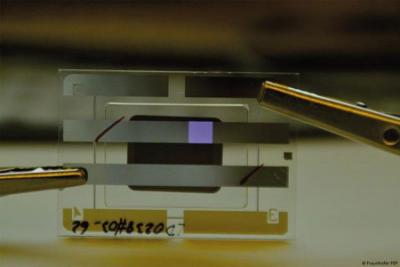
The Fraunhofer showed sample sensors that integrate both the OLED deices and photo-detectors with tunable spectral characteristics. The green OLED is a top-emitting OLED that has a thin-film optical filter and thin-film encapsulation - so that a sample substrate can be brought to be very close to the excitation source.
Pagination
- Previous page
- Page 5
- Next page



